Customer-First Marketing: the new brand playbook for the privacy-first era
Here’s a riddle for you…
If a marketer has an infinite number of different questions, but the answer is the same every time—what is the answer?
It depends.
But why does it always depend? Why isn’t there a surefire way to do things like acquire more customers, convert more shoppers, or generate more revenue?
It all comes down to your customers.
The answer is always “it depends” because each and every brand has different customers with different needs, desires, and motivations. As a result, there can never be a single, definitive resource for you to market effectively to your unique audience.
Yep, that’s right. That means every single “ecommerce marketing playbook” you’ve ever been sold is a lie. Maybe not entirely, and maybe not a lie for everyone, but the harsh truth is that no playbook works effectively for every single brand because every single brand has different customers.
Besides, if everything was as easy as implementing a playbook, wouldn’t every online brand be incredibly successful?
They aren’t. And that’s what this guide is here to help you with. This guide is here to plant a seed, which hopefully we grow into a mindset shift entirely. That shift is toward Customer-First Marketing, which we’ll explain in depth here in a moment.
Before you continue, keep this in mind: This is a guide in a very literal sense, in that it contains guidelines to help you achieve Customer-First Marketing. It is not a template. There are no step-by-step instructions you can repeat, or a defined set of rules you can follow. This is not a one-size-fits all model you can directly apply to your brand. This isn’t a recipe for success. It’s not a growth hack, a quick fix, or an easy win—and really, you shouldn’t trust anyone who promises you any of those things, anyway.
After you’ve read this guide, that’s when the real work starts. You’re going to need to commit to taking the time to speak one-on-one with the real, live human beings who are your customers, and you’re going to need to think critically about how those insights apply to your brand.
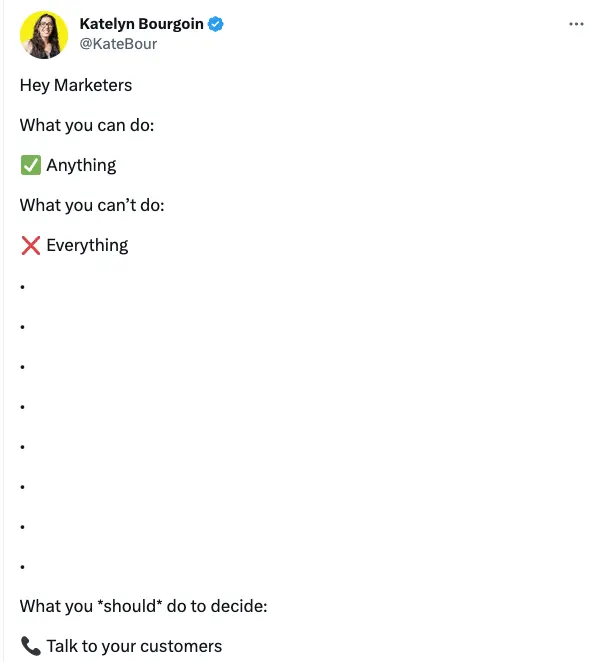
You still with us? Let’s dive in!
What even is Customer-First Marketing?
Customer-First Marketing is a strategy that considers customer needs and desires when creating a business, product, and marketing campaign. In other words, the customer-first approach means prioritizing customers’ requirements over the brands’ to create tailor-made experiences.
Why? So you can build direct relationships with your audience and cultivate a loyal customer base through curated experiences designed around what they’re interested in.
“At the root, it really means not forgetting the whole point—which is that if you don’t have customers, you don’t have revenue and you don’t have a business,” reflects Ari Murray, VP of growth at Sharma Brands and founder of the ecomm newsletter Go-to-Millions, when asked what Customer-First Marketing means to her.
It’s a basic kind of just thoughtfulness in how brands treat their customers.
“It’s how you would want to be treated if you were the shopper, and the kinds of things that would make you want to come back—a basic kind of just thoughtfulness in how brands treat their customers,” Murray says.
Customer-First Marketing can trace its roots back to the principle of human-centered design.
People designing experiences for people
Human-centered design is an approach to creating solutions in partnership with the people you’re creating the solution for.
This helps you as the designer, or marketer, understand what motivates your audience—and subsequently build an end product that your audience feels emotionally connected to.
Without this partnership, you’re really just grasping at unfounded assumptions.
“I think we often get lost as marketers in what we think our customers want. And without having conversations directly with them, we’re just creating products or messages based on our own assumptions,” says Monica Grohne, founder of Marea Wellness.
What’s more, the emotional connections you build with your audience can have a transformative effect on how they view your business.
“The more conversations you have with your customers, the more they’re going to get to know you [marketers or founders] as an individual, as opposed to feeling like brands are just these expendable, inanimate objects,” says Grohne. “They start to realize that there are humans behind brands as well. And humans buy from humans.”
Customers start to realize that there are humans behind brands as well. And humans buy from humans.
Murray agrees. “Let’s say you have a new product launching and you don’t know what color it should be. The solution? Ask your customers who bought a different variant of the product last year? Email them with a poll and let them choose,” she says.
“Let your audience into your business. Let them think they are a part of something and root for you—it’s a great way to bring them into the fold.”
This partnership begins by talking with the people who make up your brand’s audience—yes, on the phone—and you sustain it over time by keeping up those conversations.
It’s not a one-and-done, check-the-box chat. It’s a business-long commitment to carve out time each week, month, or quarter to get to know the people who’ve interacted with your business—positively or negatively.
“A lot of brands have interesting stories, interesting products, and interesting ways that people interact with their products. And that means every brand’s secret sauce should be talking to your customers—see how they interact with their brand, how they see your brand, how they see your products,” says Zac Cherin, founder of Sidekick.
“Once you determine how people interact with your site, your emails, and your texts, you’ll have a much clearer picture of each channel, and how you can improve it.”
While some marketers or business owners take this human-centered design approach as they strategize product development and website design, few are applying it to the marketing experiences they launch.
But that’s exactly what you should do.
“Customer-First Marketing is really understanding who your customer is, what experiences they’re going through, and what problems they’re facing. That way you can solve those things with your product and clearly explain them in your marketing programs,” explains Ezra Firestone, CEO of Boom by Cindy Joseph, and founder of Smart Marketer and Zipify Apps.
Customer-First Marketing begins by:
- Talking with your customers
- Prototyping the experiences you want to build based on those conversations
- Figuring out what Customer-First DataTM you need to power those experiences
- Then building those experiences with that data.
The result? Attracting more customers, increasing retention, and earning brand loyalty once you put your innovative new experiences in the market.
The 3 components of Customer-First Marketing
There are three components to building a successful Customer-First Marketing strategy. You need people (your audience), data (their documented interactions with your brand), and experiences (how you translate their interactions into brand actions). Full stop.
1. It all starts with your people (your customers, fans, community, partners, subscribers, audience, etc.)
Without the people who interact with your brand, you can’t even begin to formulate a Customer-First Marketing strategy, much less run a profitable business.
These people are those who visit your online store, follow and interact with your brand’s social media accounts, subscribe to and engage with your email and SMS channels, and who buy your products.
They make up your brand’s audience and will teach you what experiences are and aren’t working. So, talk to them!
“A lot of entrepreneurs are the consumer they’re selling to, so they have the innate experience themselves. But you still have to do true customer research,” says Firestone.
“Reach out to people who you know who are in your customer demographic,” he says. “Call them and talk to them. Interview them, ask them about their life, about their experiences, what they go through, what they’re interested in, what they’re afraid of.”
2. You need data, but not just any data—Customer-First DataTM
The data you use to power your Customer-First Marketing strategy comes from, you guessed it, your people.
Information like:
- Their contact information
- Their shopping preferences
- How frequently they buy from you
- What text messages they click on
- What kinds of emails bring them back to your site
All of this will help you form a better understanding of who your audience is—essentially, what they care about and what motivates them to buy.
This data is Customer-First Data, or information that’s sourced directly from a prospect, website visitor, or a customer. It’s made up of:
- Personal details that someone proactively gives you, like their email address, phone number, or birthday
- Behaviors that you observe from the actions someone takes on your owned channels, like what products they browsed on your site or what link they clicked in your email
You can get permission to collect this data in a variety of ways:
- Signup forms, like popups, flyouts, or embedded forms (often found in the header or footer on a website)
- Quizzes
- Landing or registration pages
- Notification opt-ins (eg. back-in-stock)
- Checkout processes
- Account creation processes
- Surveys
- Preference centers
- Requests for customer feedback
“Of the total number of people who come to your site for the first time, how many are you giving you permission to contact them?” says Cherin. “What can you do with an opt-in form to provide immediate value to a new user, while also increasing the percentage of people who subscribe?”
But collecting data means you’ll need a place or a system to store it. A customer platform, like Klaviyo, will allow you to keep your data centralized and ready to use in an actionable way—an excellent segway into the last component of Customer-First Marketing.
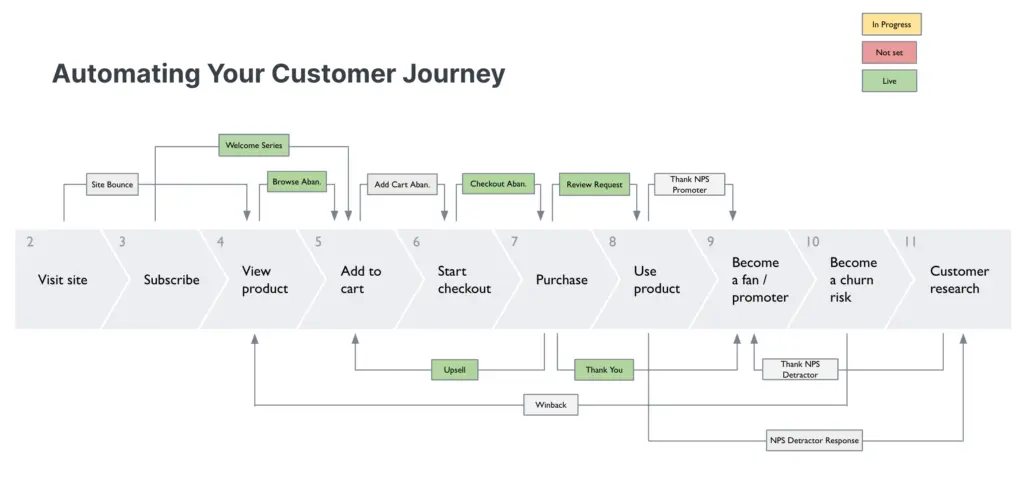
3. Finally, your data is only as good as the experience you activate
The pinnacle of Customer-First Marketing is the individualized experience you’re able to create from the data you’ve gathered.
This marketing strategy allows you to design more meaningful interactions with your audience because you already know what they prefer.
From the products you recommend, to the time of day you send emails and texts, or the educational content you share, Customer-First Data, in combination with your customer conversations, will help you personalize each stage of the online shopping process—and ultimately, forge lasting relationships.
Take it from Grohne, whose customers “are the beating heart” of her brand.
“If you can create a relationship with your customers where they know you genuinely care about what they’re thinking about and how they’re interacting with your product, it’s not only going to strengthen your brand, but it’s going to make the overall experience—one that your fans, your customers, are going to want to tell others about,” says Grohne.
Now that you know what makes up a Customer-First Marketing strategy, let’s dive into what the phases of building out this kind of strategy look like for your brand.
The 5 phases of Customer-First Marketing
There are five phases of Customer-First Marketing, which will take you from guessing what your customers want to truly and deeply understanding what they need.
Let’s go through what each phase consists of and how you achieve it.
1. Goal setting
Before you do anything else, you first need to determine what your goals are.
“First and foremost, you have to have a goal in mind because you have to understand what it is that you want to do with your research before you set out to do it,” says Val Geisler, former customer advocacy lead at Klaviyo.
“Your goals will shape how you go about that conversation and they’ll inform how you go about talking to your customers. You won’t know who you need to talk to or what you need to ask of them until you know what you’re going to do with the end results.”
Common goals for ecommerce brands are:
- Increase website traffic
- Improve onsite conversion rate
- Increase retention rate
“A conversation about retention is different from an acquisition conversation,” says Geisler. “What does an existing customer need versus what does someone who’s never heard of your brand before need? That’s totally a different conversation with different questions you’ll want to ask a different group of people.”
Additionally, while developing broader goals is a good place to start, it helps to have an idea of how you want to achieve those goals:
- Increase website traffic → Identify new marketing channels to try, identify current marketing channels to increase investment in, identify how to make the content you’re currently promoting at the top-of-funnel more relevant to new shoppers
- Increase onsite conversion rate → Increase newsletter opt-ins, decrease cart abandonment rate, increase purchases made by first-time visitors, or increase a welcome series click through rate
- Increase retention rate → Increase repeat purchase rate, increase average order value, or improve the post-purchase experience
How do you determine whether to go wide or narrow?
“Sometimes the impetus for these conversations comes from your customers. You hear it enough times, whether it’s through social media, reviews and surveys, or someone on the support team responding to tickets,” says Geisler. “If you’re asking general marketing-related questions, it will likely give you good content and help you better understand your customers, but it’s more valuable to go in knowing what you’re interviewing about.”
Once you have your goal, you also need to consider what you want your outcome to be, according to Adrienne Barnes, founder of Bestbuyerpersona.com.
“Once you know what you want the outcome to be, you can go in and decide the best questions to ask,” says Barnes. “Ask as many questions as you can, and think about how they can get to the answers you need.”
While it’s helpful to have both overarching goals and more focused ideas of achieving those goals to guide the conversation, you want to remain open-minded about the course of the discussion. This allows the customers you talk to disprove your original theories or take the conversation in a new direction.
“Interviews should start soft and get more pointed as you go, but there are definitely times where the interview goes in a direction you don’t expect it to go and you should be prepared for that,” says Geisler. You can always use that feedback either for what you’re currently researching or in future projects.”
Interviews shouldn’t be just questions and answers—it’s a conversation.
“Interviews shouldn’t be just questions and answers—it’s a conversation. And with that understanding, you’re not always going to be in the driver’s seat, but starting with a goal that you want to address is how you at least keep the interview on track.”
2. Inspiration and architecture
The inspiration phase is where you learn directly from the people you’re marketing for as you immerse yourself in their lives and come to deeply understand who they are.
This is where you pick up your phone or hop onto Zoom (camera on) and speak one-on-one with your customers to collect insights.
But how do you decide who to talk to?
Once you’ve established a goal, you can begin identifying the best people to speak with.
Here are a few types of customer segments to consider:
- Loyal customers: These are your happiest customers and the biggest fans of your brand. There are a myriad of ways to determine what a loyal customer looks like, but consider evaluating people who have a high lifetime value (LTV) and are engaged through other means—maybe they leave product reviews, or have referred a number of friends. These customers are likely the most willing and excited to provide feedback because they’re invested in the success of the business—mainly because the product has proven to effectively meet a need for them.
- One-time purchasers: These customers have gone through the full buyer’s journey, will speak honestly and candidly to their thoughts about the product, brand, and purchase experience. Depending on the time that’s elapsed since their first purchase, these customers can give you valuable insights into why they haven’t made another purchase, or they can give you timely feedback on your store as it exists in the present.
- Subscribers who haven’t purchased: These people are engaged with your brand in some way—namely through an email or SMS list—and are likely considering a purchase but haven’t pulled the trigger, for whatever reason. They can tell you their motivations for purchasing and what is lacking from your brand that’s prevented them from making a purchase.
- Lapsed or unhappy customers: Again, there are a few ways to determine this group—it could be people who left a negative review or someone who purchased before and never came back. But these are the people who will give you the most honest, critical feedback about your brand.
Pro tip:
You can build these segments in Klaviyo and then reach out directly to set up a call, just like Grohne does with her customers.
Here’s an example of a post-purchase email from Marea Wellness, which Grohne automated to send after a subscriber orders three times, that requests a conversation and links off to her Calendly to set up calls with customers.
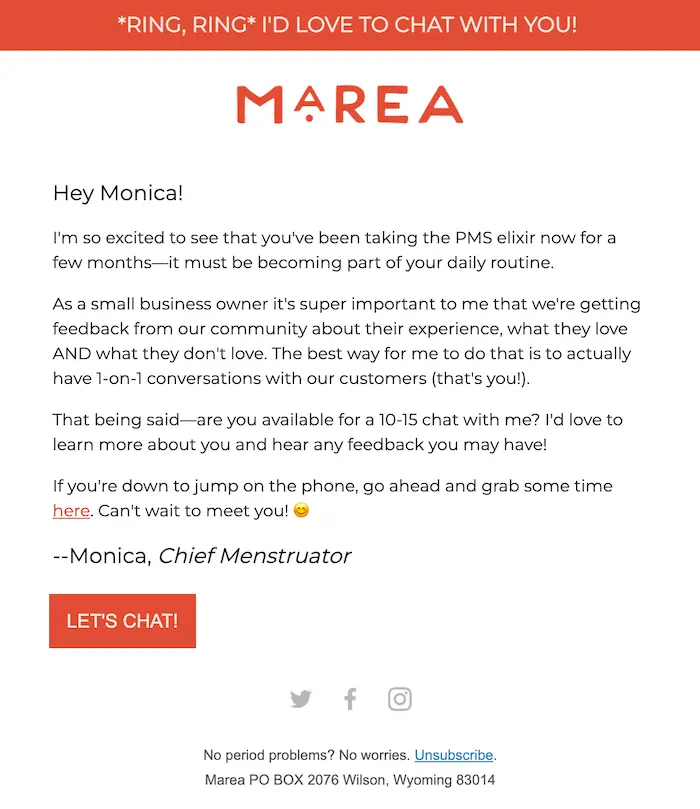
These conversations should be informed by the goal you determine in the first phase. Once you collect your insights, you can start unlocking new opportunities.
And that begins with a brainstorm.
Now, you have to make sense of what you learned and identify which new programs, campaigns, and brand experiences you’ll design based on customer feedback.
“The best way to understand which ideas to try first is by understanding the priorities of your business, and also being willing to be wrong about those things,” says Geisler. “A customer might tell you something that feels totally off, but if multiple people are providing the same feedback to you, you might want to consider why it feels off. There’s a point where you are no longer your brand, where your brand is really defined by the people who purchase from you.”
There’s a point where you are no longer your brand, where your brand is really defined by the people who purchase from you.
Perhaps this means implementing a totally new experience, or maybe it means adjusting your approach to the marketing you’re already doing.
But it’s important to spot the patterns in the customer insights you’ve collected, and use those to take the next step.
“Look for repetition. If you’re seeing the same comments being made, the same frustrations being mentioned, the same delights being mentioned or questions being posed, those are things to pay attention to,” says Barnes. “An insight is one piece of information, multiple insights become a data point. When you’ve heard something happen over and over again, that’s when it starts to become valid feedback.”
When you’ve heard something happen over and over again, that’s when it starts to become valid feedback.
Once you recognize these patterns, think about what you can do to address them—what tools can you use to help guide the customer on the journey, or what experiences can you implement that will get them from whatever point A is to point B?
Still feeling stuck? Here are a few ways to translate customer insights into actionable ideas:
- If you find that people often want to compare your product to competitors before purchasing, consider adding a comparison guide to your welcome series or your abandoned cart series.
- If you find that shoppers are saying they’re faced with too many options when they’re browsing, consider implementing a quiz that provides product recommendations as a result.
- If you find first-time purchasers are saying that they received the product but don’t know how to use it correctly, consider implementing a guide on how to use the product in your post-purchase follow up.
- If you find that your best customers are always telling their friends about your product, set up a referral or affiliate program.
- If you find that customers would benefit from a reminder to repurchase when the product is running low, consider implementing a replenishment automation or setting up a subscription membership.
The important thing to remember is that after you come up with an idea, you’re running a test—you’re not committing to change these elements for good.
That means, you can always iterate, improve, or even reverse the experiment completely if it doesn’t achieve the desired results.
For this reason, set a timeline for how long you want to run the experiment before you go to the next step of implementation. Depending on what you decide to do, this timeline could look like 30, 60, or 90 days.
Note: We get it—the idea of running a test is scary. You don’t have time to throw spaghetti at the wall. That’s why it’s so important to talk to your customers. This way, there are no guessing games involved. You’re collecting insights from the exact people you want to delight every day, so you’re going into every experiment with the knowledge that the ideal outcome will be impactful to the people who matter most.
3. Implementation and data mining
This is the phase where you take your customers’ feedback and use it to bring new experiences to life for your brand. During this phase, you’ll also identify what data you need to craft these experiences and mine your database—or begin to collect it.
The focus here is on surfacing Customer-First Data to create the prototyped experiences.
Quick recap: Customer-First Data is information that’s sourced directly from a prospect, website visitor, or a customer. It’s made up of personal details that someone proactively and explicitly gives you or behaviors you observe from the actions they take on your owned channels.
Let’s look at a few examples to drive this home.
How Cheeky Wipes uses customer feedback to fuel more data collection
After hearing from her customers that some of the content surrounding certain Cheeky Wipes could be perceived as triggering, founder Helen Rankin set up a signup form that allows shoppers to choose what items they’re interested in hearing about.
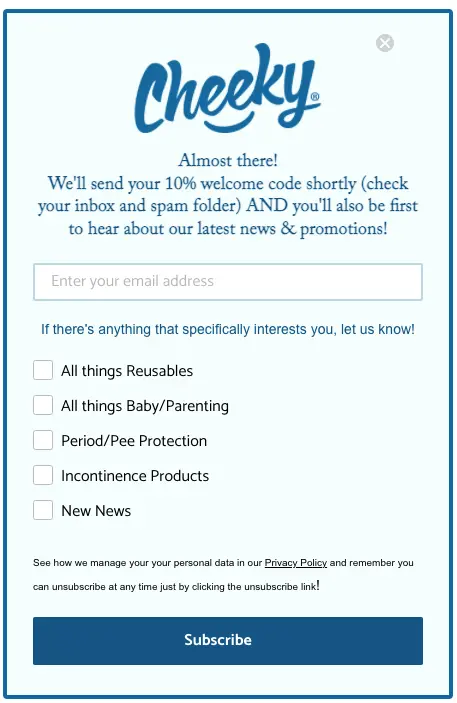
Once shoppers state their preferences, Rankin uses that customer-first data to send information to subscribers about only the products they want to hear about.
Not only does this help avoid sending content surrounding sensitive topics to the wrong individuals, it also helps more accurately target campaigns and automations and ultimately create more relevant experiences for all Cheeky Wipes customers.
For example, based on how a shopper responds to the above signup form, they’ll receive one of three different versions of Cheeky Wipes’ welcome email, which Rankin can personalize using profile properties.

“It goes back to getting the right message to the right person at the right time,” says Rankin. “We’ve found that allowing people to state their preferences at the beginning makes for an overall better customer experience.”
We’ve found that allowing people to state their preferences at the beginning makes for an overall better customer experience.
How insights from Marea Wellness customers lead to a quiz
Monica Grohne has regular conversations with her customers, after which she realized that many had questions about how Marea Wellness’s signature multivitamin elixir would specifically help their individual symptoms.
As a result, Grohne implemented an Octane quiz that will both match her business model and her customers’ needs.
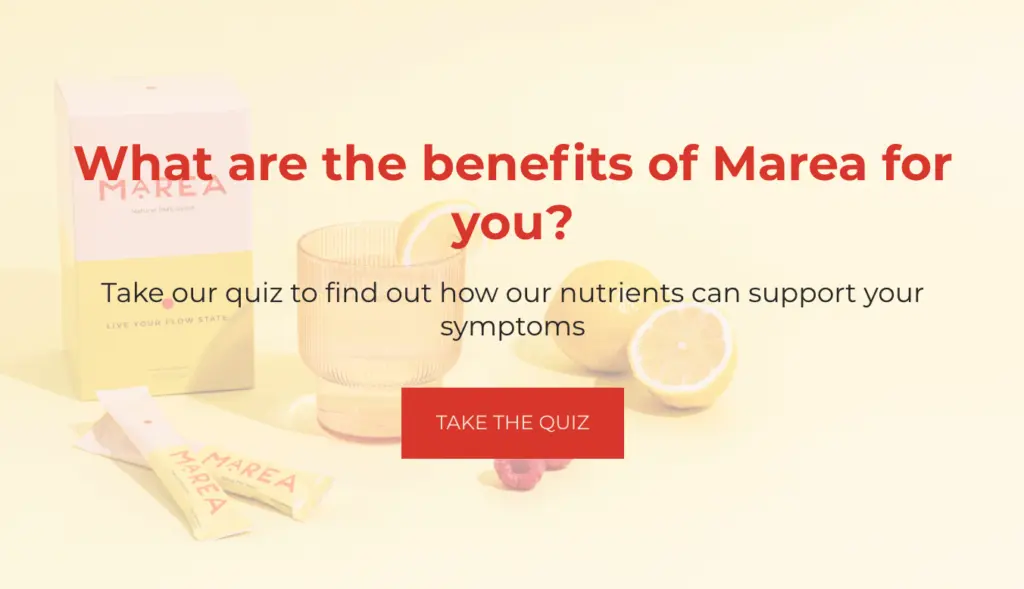
“One of the things that we hear most often from our customers is, ‘How is this going to help my symptoms?’ It’s not like we can do a quiz and suggest a product, because we only have one product. Everyone would get the same results,” Grohne observes.
“Instead, we wanted to figure out how we could have people input what their symptoms are—then we could tell them how the nutrients in our product support their symptoms. This way, we’re educating the customer on our product based on their needs and narrowing in on the ingredients that support their symptoms,” she adds.
“The quiz is a new approach to product education that was based off of a general question that we kept receiving.”
How customer conversations impacted Three Ships Beauty’s merchandising strategy
Lillie Sun formerly headed up growth at clean skincare brand Three Ships Beauty, and found that one of the best resources for impacting the brand was their customer advisory board.
“Our Fleet Insiders are our community VIP exclusive members—they’re very much cult fans of Three Ships,” says Sun. “They’ve spent a lot of money with us, are consistently using our products, and we get a lot of insight from them on the marketing side of things including what promotions they like to see, how they like product launches to be framed, what kind of exclusive events we should do.”
Sun noted that the brand has seen success bundling a number of products together for a discounted price because people typically don’t just buy one product at a time. The insight to do this came from her customer conversations, which helped her identify which products to include in the bundles.
“The way we decide on which products to bundle is informed by customers, both in terms of us explicitly asking them their go-to products and also seeing if there’s any consistency between the 500+ members we have,” says Sun.
“That’s how we’ve built out a lot of the bundles that we have now, such as the Defense Bundle, which is three products suited for mature skin. We found customers were constantly buying these products together, and they’ve explicitly told us that they work well together, so we decided to bundle it and market it as one product,” she explains.
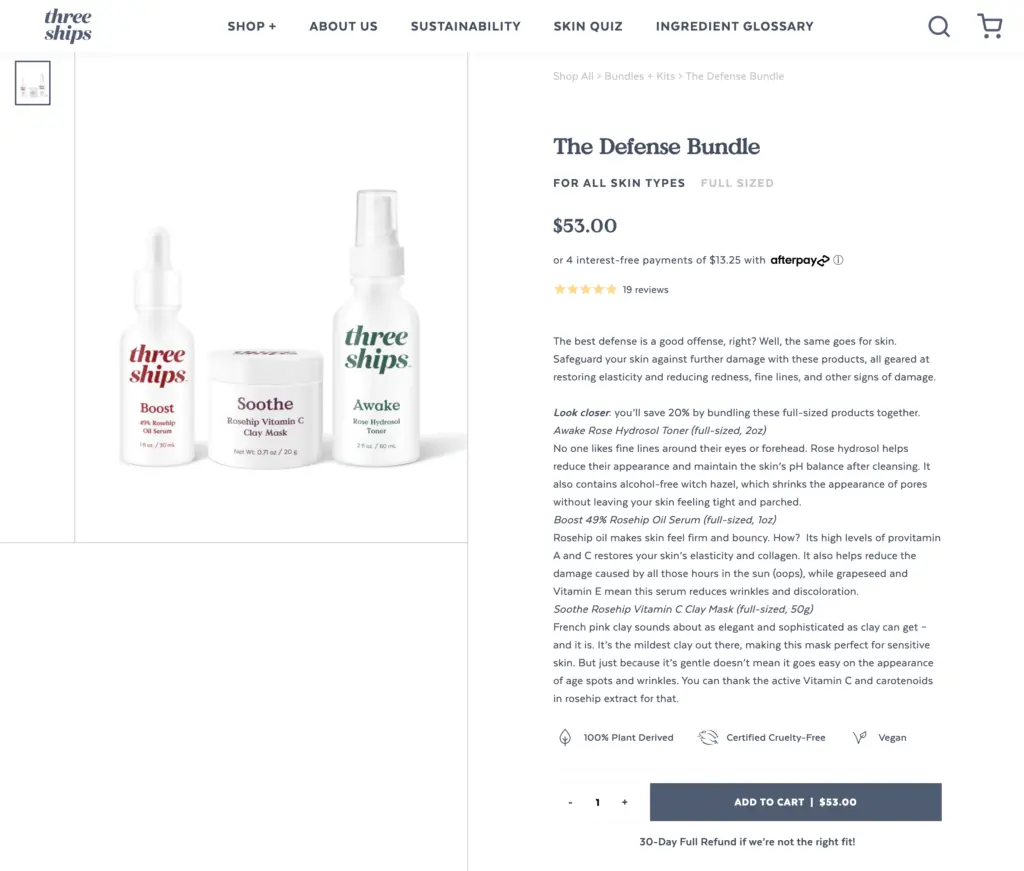
On the other hand, Sun attempted to implement bundles that weren’t based on customer feedback, and experienced first-hand how critical those insights were to the brand’s success.
“For Valentine’s Day, we launched a bundle of two serums, and this was not based on customer feedback—we decided internally that we wanted to do it,” says Sun.
“We put tons of marketing power behind it—we made new assets, we built emails for it, we planned so many things on the social calendar to talk about it, we built a great product page—and people just really weren’t interested. Ultimately, it didn’t do as well as our other bundles, so we’re not doing it next year.”
4. Measurement and automation
This phase is where you measure the success of the experiences, and iterate upon them with additional Customer-First Data.
Very few, if any, marketing activities should have a one-and-done approach. Instead, you should constantly measure, iterate, improve, and test new solutions.
For example, after every piece of customer feedback that is turned into a marketing tactic for Three Ships, Sun benchmarks the success based on target goals and past performance to help decide if it’s worth repeating.
This step also helps save a lot of time, effort, and money, so you’re not investing a lot of your marketing dollars into something that won’t resonate with people and won’t have a good return, as Sun discovered with Three Ships’ Valentine’s Day campaign.
Once you realize what works, the next step is translating those distinct patterns of behavior (the data) into automated personalized experiences so that your website visitors, customers, and subscribers feel like your brand is tailored to their wants and needs.
You’ve talked to your customers, collected thousands upon thousands of data points on your audience, and found some indicators for success. Now what?
Now it’s a matter of using your customer platform to organize that information into customer segments and send personalized campaigns at scale.
Personalized messages go beyond just including someone’s first name in an email. “Personalization, from a Customer-First Marketing perspective, is about understanding what someone wants, when they want it, and how they want to receive it,” says Sun.
Personalization, from a Customer-First Marketing perspective, is about understanding what someone wants, when they want it, and how they want to receive it.
For example, if you were to implement a product bundle with your brand, similar to Three Ships, there are a few ways you could maximize the impact of those efforts long-term:
- Create a quiz to help shoppers discover the product bundle.
- Create a dedicated abandoned cart series targeted toward people who add the bundle to their shopping cart and don’t purchase.
- Retarget shoppers with an advertisement for the bundle on social media.
- Use an SMS campaign to launch the product bundle to subscribers.
- Create an upsell automation that sends to people who purchase any of the singular items included in the bundle.
- Implement an email pop-up for the product page that offers free shipping on the bundle.
- Add the bundle to an email in your welcome series.
- Feature the bundle on your website homepage.
It may sound like an uphill battle, especially if you have hundreds of thousands of subscribers, but that’s where technology steps in to take care of the hard part.
Once your audience’s data is consolidated into a succinct profile, you can bucket them into the appropriate segment to ensure they receive a message that’s in line with their desired experience.
Segment now, so you can personalize later
Segmentation is where you pop on that creative hat, because there are so many ways you can draw lines around groups of your audience.
You can segment by:
Location
Some of your customers may live in various parts of the country, or world for that matter, which means some of your products or services could be more relevant to individuals in a certain geographic location.
For example, if you’re an apparel brand about to launch your summer collection and you have customers in the US and Australia, you would only want to promote that collection to your US audience since your Australian customers are about to head into their winter months.
Demographic
Say you own a frozen smoothie subscription company and you collected flavor and communication preferences of your subscribers via a signup form. Those who were interested in fruit smoothies and receiving text messages would go into one segment and those who preferred chocolate smoothies and receiving emails would go into another.
Subscriber type
When and where did someone first sign up to your subscriber list: were they an in-store shopper or did they find you online?
Each type of customer could benefit from messaging that’s unique to how they discovered your brand.
Also consider whether they’re familiar with your brand: have they made a purchase before? Or are they new subscribers, who’ve also never placed an order?
For first-time buyers, include a discount in their welcome message to encourage them to purchase. For returning customers, lean into a “welcome back” sentiment rather than welcoming them for the first time.

Browsing history/cart abandonment history
Bucket your audience into various categories that align with the products they browsed or added to their cart.
For example, if someone viewed one of your most popular items—that tends to sell out quickly—add them to a segment that receives more urgent messaging in the copy versus someone who’s browsing history shows they’re interested in some of your lesser-known items.
Purchase history/frequency
How often someone places an order from your brand can be a strong indicator of how genuine your relationship is with them.
If a customer bought something from your online store months ago, but hasn’t returned since, they could be categorized under a less-engaged segment of your audience.
But if someone purchases an item from you every few months, they’re demonstrating that they’re in it for the long haul.
You can segment these repeat, loyal customers into a highly-engaged group and curate content that continues to nurture those rich relationships—like VIP programs, specialty discounts, or early-access to shop new products.
You can also build segments around what people have bought in the past—like a certain gendered product or an entire skincare regime versus just a moisturizer—or what they have not.
People who are subscribed to your email and SMS lists, but who’ve yet to make a purchase are their own breed of customer and require specific content to build trust with a brand.
“We cater to purchasers and non-purchasers differently because with the people who haven’t yet purchased, we’re trying to get them interested in the brand and trust us, so we’re sharing reviews and the backstory of Dana and the company,” says Blair Peterson, VP of strategy at Dana Rebecca Designs.
“In a cart abandonment email for somebody who’s previously purchased from us, we want to talk to them about building and expanding their Dana Rebecca jewelry collection.”
Average order value (AOV)
If you’re looking to dig even deeper into the realm of segmentation, in addition to purchase frequency, grouping your audience by their average order value can help you send relevant content to the right people.
- If someone purchases your higher-priced items, for example, they could be eligible to receive free shipping.
- Or if someone abandons their cart and is just shy of the free-shipping cut off, they could receive a specific abandon cart message encouraging them to add more items to their cart to reach the designated threshold.
Segmentation helps you identify where your audience fits within your content strategy, but it’s your automations that bring them home.
Do less, sell more: the combined power of segmentation and automation
Once you figure out how best to segment your audience, apply those thoughtful groups to the automations, or flows, you set up.
An automation is a message (either an email or text) that’s triggered to send based on the action someone takes on your website, or engagement with your customer communication via email or text message.
They’re meant to entice your subscribers to interact with your brand, whether that’s returning to your site, completing a purchase they started, or simply returning to make a purchase after a buying dry spell.
Splits, or flow filters, are an automation’s best friend. It’s like the jelly to its peanut butter—one makes the other better. They’re also where your audience segmentation can join the party.
What are they? Splits are where you designate certain individuals to go down one path of your automation and others to follow a separate one. The flow above that sent different messages to purchases and non-purchases is a great example of a split. Here’s a more in-depth example:
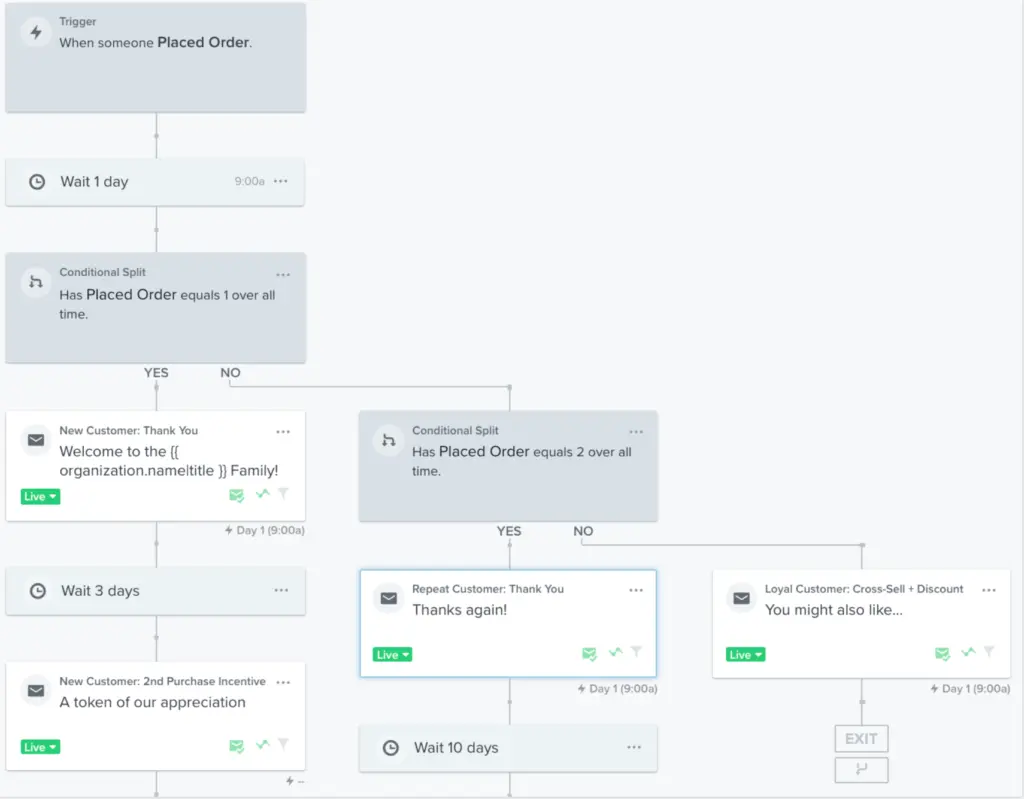
The more data you have about your audience, the more splits or branches you can have in a given automation—resulting in more personalized messages and tailored experiences for your recipients.
You can set up these splits to occur at the event or behavior level (also called a trigger split) or based on the unique properties of your segments (also called a conditional split).
Here is how you can apply your segments to some of the top performing automations (with splits):
Welcome series
Welcome automations are ripe with opportunities to segment based on zero-party or first-party data you’ve gathered from your audience.
You can create a welcome series and add in a conditional split based on whether:
- Someone has purchased from your brand before or not
- Someone prefers to receive emails or text messages
- Someone is an international customer
Or you could segment your automation based on other demographic information, like if a subscriber has specified they’re shopping for women, men’s, or unisex items. Here is what that looks like in Klaviyo:

Much like Dana Rebecca Designs, OSEA’s welcome email for new subscribers who haven’t made a purchase yet is all about building trust in the brand and its products.
Their initial welcome email focuses on the founder’s story, the values their brand is built on, and the quality of their carefully chosen products. Plus, they include a welcome discount as an incentive to encourage new subscribers to buy.

Browse abandonment
A browse abandonment automation is incredibly effective in bringing your brand back to the forefront of your subscribers’ thoughts.
It’s a friendly little nudge to say, “Hey, remember me?”
You can create a split (conditional and trigger) in your browse abandonment flow based on (to name only a few):
- How many times someone views a certain product on your site
- The price of the items viewed
- How many items they viewed
- Whether or not they’ve made a purchase recently (it might not be a great customer experience if someone receives a browse abandonment email two days after they purchased an item)
You can also add a dynamic content section so that the items your site visitor was looking at are displayed in the body of your message.
Cheeky Wipes segments their browse abandonment email by how many products a site visitor views during a session, and uses varying copy to engage different behaviors.
If someone views multiple products while on their website, Cheeky Wipes includes a customer review from someone who’s placed multiple orders in their browse abandonment email.
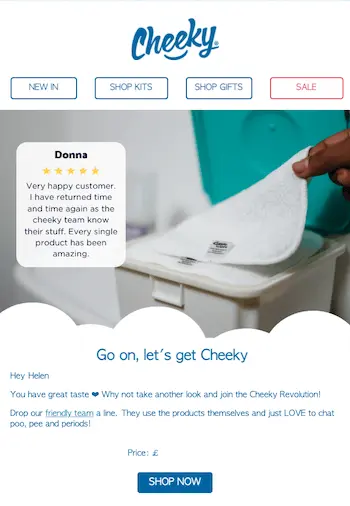
But if someone only views one or two products, the brand includes a customer review that speaks to the high quality of the product.
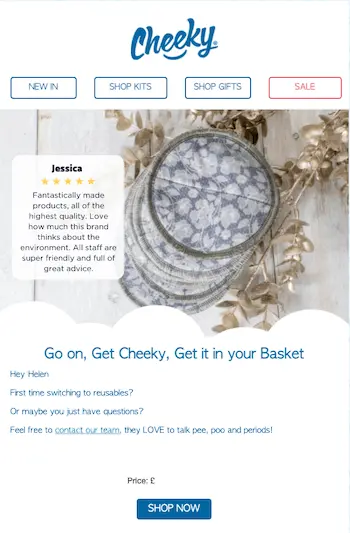
Cart abandonment
A cart abandonment automation is like the browse abandonment flow but kicked up a notch. It’s triggered when a subscriber adds an item to their cart—displaying a high intent to purchase.
This is a prime chance to give your audience what they’re looking for, when they’re looking for it.
You can add a trigger split to your abandoned cart flow to send people with higher-value items in their carts more enticing copy—like free shipping, or a discount on their order.
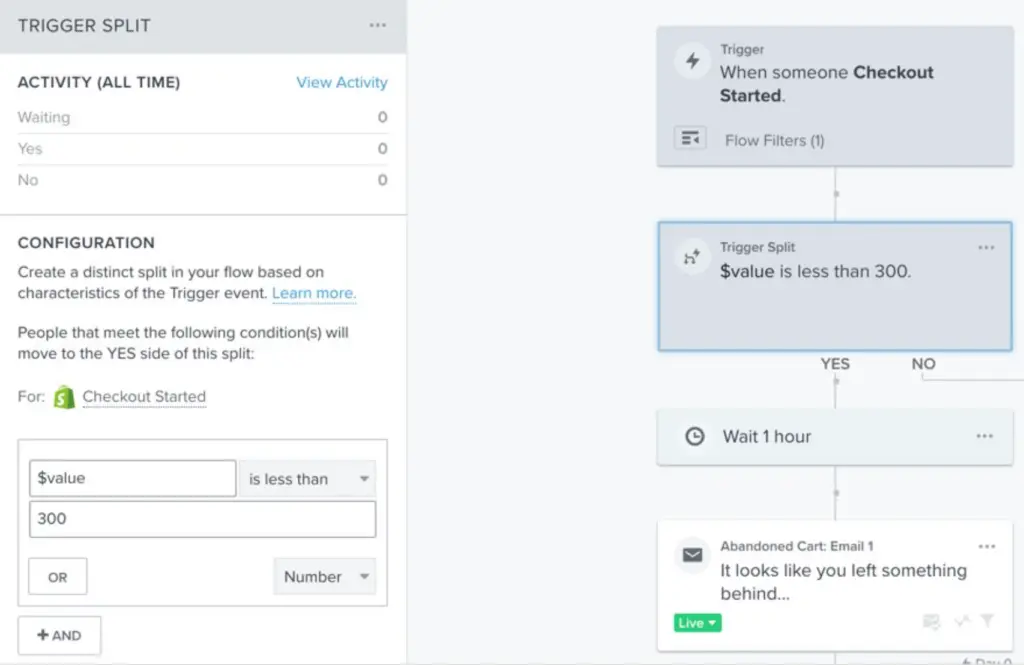
Or you could add a conditional split based on how many items someone left in their shopping cart. If it’s more than say, one or two, tease a tempting discount and include a link that brings shoppers directly back to their cart.
Outdoor Voices employed such a strategy with their abandon cart email.
For a subscriber that has multiple items in their cart, their email includes an impressive discount and a prominent button link that brings the shopper back to their original cart.

Back-in-stock
Back-in-stock automations are triggered when someone signs up to receive a notification when an out-of-stock item becomes available again. They’re high-intent because they show that a subscriber was trying to add a particular item to their cart and was unable to do so.
You can use Customer-First Data to create VIP segments within your back-in-stock automation. If customers have a reputable track record of shopping with your brand, they could receive the back-in-stock message before subscribers who’ve never made a purchase, for instance.
If you’re facing large-scale fulfillment issues and have multiple items out-of-stock you could also segment by the item itself, in combination with the purchase history of the subscriber.
BABOON TO THE MOON, a brand popular for the limited-run prints they include in their indestructible travel bags, brought back a specialty print that flew off the shelves.
Their back-in-stock email included a link to shop the products and detailed which products were brought back.
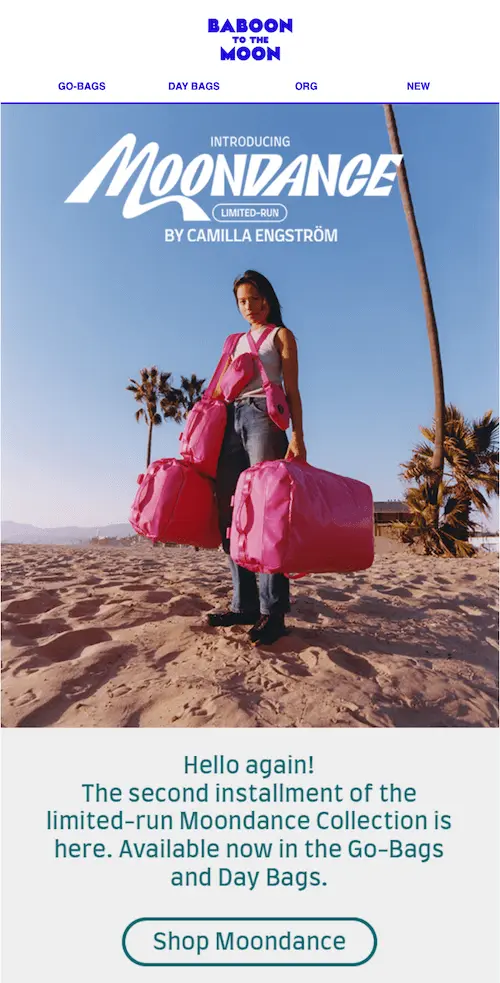
Your customers can hand you the information you need to create a successful marketing strategy—so ask for it! And use it to craft experiences they’ll find valuable.
Cross-sell or upsell
Cross-sell and upsell automations allow you to target shoppers based on their purchase history in order to suggest related products that are either complementary or additive to their past purchases, effectively increasing LTV.
Here is what that flow looks like in Klaviyo:
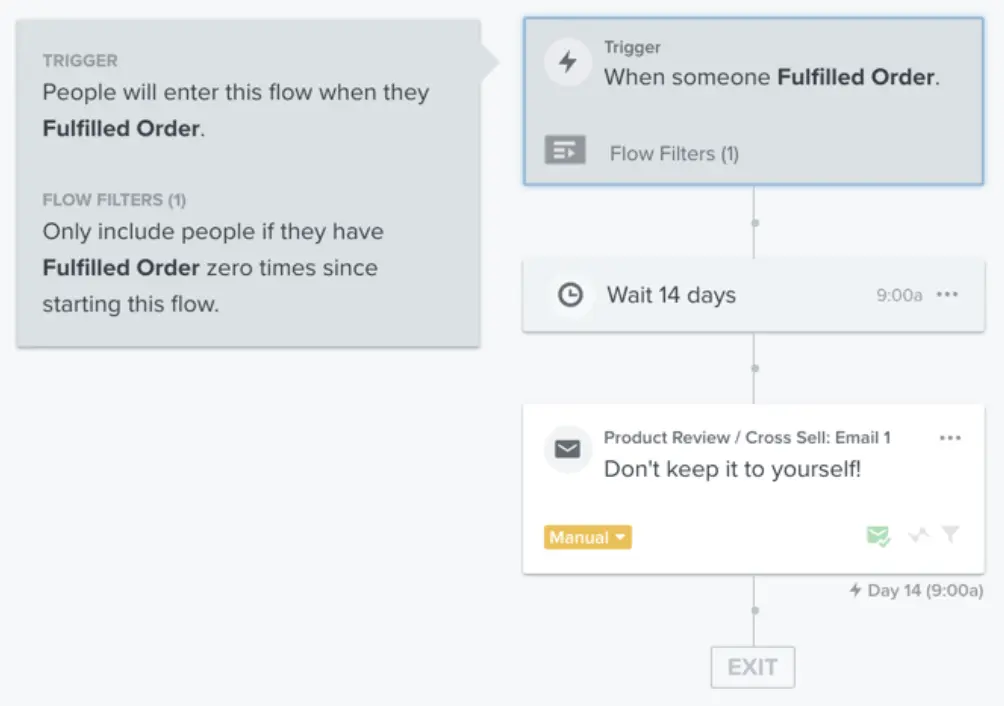
One brand that nails the cross-sell is House of Wise.
Once someone buys their CBD stress gummies, they follow up with an email about trying their sleep gummies, emphasizing that many of their customers buy the two together. The brand offers a 10% discount for people who want to try both, too.

5. Repetition
This phase is where marketers begin the entire process over again, and on a regular basis, to continue to improve their marketing effectiveness, retention, and brand loyalty.
“Never stop talking to customers and doing research with your audience,” says Barnes. “It’s a matter of continuously doing the customer interviews, having those conversations, collecting the customer research, and always with your eye on the goal.”
Additionally, while you should continue to speak to customers on a one-to-one basis regularly, there are also ways to collect customer feedback intermittently in ways that are more scalable:
- Surveys: Send out surveys at different touch points—immediately after someone makes a purchase, a few weeks after they receive their delivery, a few months after they receive delivery, or once they make a repeat purchase are all moments where customers might be able to provide pointed feedback that’s relevant to different parts in the user journey.
- Two-way messaging: Use conversational text messaging to target segments of customers such as VIPs, one-time purchasers, or repeat purchasers to collect feedback on a regular basis. You can also invite responses to emails by including a quick one-question note or P.S. at the bottom of your copy—just make sure it’s not coming from a no-reply address.
- Community engagement: Creating experiences isn’t a ‘put it out there and be done with it’ activity. You need to respond to the community on social channels and in groups. Get feedback from folks, implement that feedback, and continue to iterate on your experiences as often as you can. Some brands even build out their own communities on Facebook, Instagram, Slack, or Discord, where loyalists give honest, regular feedback on brand activities. That community can include your 100 biggest fans, or include thousands, especially if you serve a niche audience who wants to come together over a passion.
- Customer support: Your customer support team is a goldmine of customer insights—they have access to questions, comments, and feedback galore. Connect with your customer support team and mine your support channels (including your customer service platform, your social media inboxes, and any other channels you use to connect with customers) often to spot patterns on a larger scale that you can use to implement Customer-First Marketing strategies.
- Owned channels: Your owned channels—including your website, email, and SMS—are the places where you have the best access to and control of hoards of customer data. And because there’s so much of it, this data can provide clues on how to improve your customer experiences. Metrics like email and SMS click rates, opt-in rate, conversion rate, and much more will give you hints toward what’s resonating and what isn’t.
These channels will allow you to continue to collect customer insights and Customer-First Data in a way that’s scalable. When you balance these efforts with talking to customers one-on-one, you’ll have a wealth of information you can use to configure top-notch customer experiences that resonate.
“You want to think about the fact that one-to-one time is so high value, you want to make sure that you leverage it appropriately, and that you use it when you’re going to get the most out of it,” says Geisler.
Customer-First Marketing is the new ecommerce playbook
Customer-First Marketing is a strategy you should employ now, and here’s why:
The cookie-less future: an uncertain future for third-party data
A privacy-first mindset is growing in prominence and practice—and it’s affecting how businesses market to consumers due to changes like Apple’s iOS privacy updates, and various global policies including GDPR and CTIA.
These new policies remove the ability for brands to easily and inexpensively use third-party advertising tools, like Facebook, to consistently get in front of new audiences.
Ultimately, this means that brands who rely less on stalking their customers and instead prioritize talking to them will have the upper-hand when it comes to withstanding these data privacy changes and as well as other changes to come.
Power to the people: consumers have more buying power than ever
In 2020, consumers flocked to online shopping in record numbers as global retail ecommerce grew by 25% in one year.
This shift coincided with a social media maturation of consumers. They become more aware of how the social platforms they engage with work, in terms of selling their data to other third-party sites, and bore witness to data breach after data breach.
Now, it’s the people who have the power, and user-generated content, influencers, word-of-mouth, and organic content on newer platforms like TikTok are breeding grounding for building successful communities on a customer’s own terms, It is increasingly becoming these communities that determine whether brands will grow or fail.
The new frontier of acquisition is nurturing your community and leveraging your current customer base, which makes Customer-First Marketing essential to any modern brand.

“The future of acquisition has less to do with finding pockets of people that don’t know you—and letting people who do know you, find people that they know. It’s a way to establish a better quality connection from the beginning,” says Jake Cohen, VP of Shopify at Klaviyo.
Competition galore: brands need to better connect with their customers
New brands and online businesses are popping out of the ground like daisies. A record-breaking amount of new-business applications were filed in the US in 2021, 5.4M to be exact, according to the US Census Bureau.
While not all of these businesses will stand the test of time, it does reflect that the entrepreneurial spirit is alive and well.
This means that:
- More brands are competing for the same consumers
- Brand loyalty is decreasing as 46% of consumers are shopping with new brands, according to data from Klaviyo
- The proliferation of tech tools has made it easier than ever to start up
It’s hard to keep relying on the same old tricks everyone else is and has been using—the “basics” of personalization, like including first names in your emails, is simply not enough.
Customer-First Marketing is a different mindset altogether—not growth marketing, not conversion rate optimization, but organizations and experiences built from the ground up for their customers, not their bottom line.

Customer-First Marketing is about organizations built from the ground up for their customers, not their bottom line.
“Truthfully, it’s just a lot easier and more time efficient to talk to your customers,” says Sun. “I can rack my brain to think of the best way to do something, or I can ask my customers—and it’s a lot easier than trying to guess. You’re already so limited in your resources, and your customers are one of the best resources you have. Just talk to them.”
You’re already so limited in your resources, and your customers are one of the best resources you have. Just talk to them.
The big data glut: marketers must determine what data matters most
Over the last decade, marketing teams have collected thousands of data points on their audience. It can feel overwhelming trying to figure out what data is actually going to make the biggest impact on your decisions when you have an almost unlimited supply of information.
With AI and machine learning on the rise, smart technologies were supposed to help people make sense of all this data—but data platforms, on their own, aren’t actionable.
You need human inputs and intelligence at the top of the system to make the entire machine work.
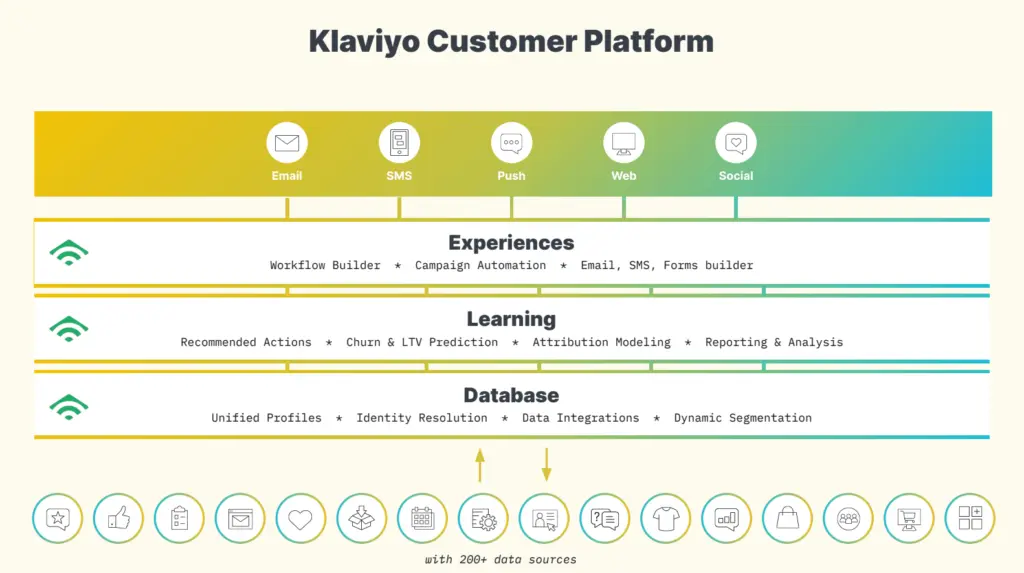
Customer-First Marketing starts with getting to know your customers and designing experience prototypes based on those conversations—with help from the processing power of your customer platform—which helps you eliminate erroneous data.
From there, it’s the interactions your customers have with those experiences that allow you to build a Customer-First Marketing organization.
Get to building a better business for the future, right now
Sure, a brand starts with the founders and teams who create it. But the way a brand grows and evolves is through the very people you created it for in the first place—your customers.
“With most ecommerce businesses, there are going to be competitors that are doing something similar to what you’re doing,” says Barnes.
“Brand is what your business is ultimately going to stand on, so you want to figure out what it is about the brand that resonated or didn’t resonate—that’s why you talk to your customers, because it gives you clarity into who you’re creating for and what they need.”
Klaviyo can help you with the data collection, mining, and experience creation launch, but what you build based on the feedback your customers give you is all yours—and it’s going to be inherently unique to your brand.
What you build based on the feedback your customers give you is all yours—and it’s going to be inherently unique to your brand.
Again, there’s no template you can use or rules you can follow. You just need to talk to your customers, get creative, think outside the box, and build a legacy brand people will be inspired to engage with.
The ball is in your court.
Customer-first marketing FAQs
Why is it important to put customers first?
Prioritizing target audiences’ wants and needs helps brands increase customer satisfaction and motivate them to take the desired action. As a result, organizations record an increase in brand awareness, but more importantly, in retention, sales, and revenue.
What are the key components of customer-first marketing?
The 3 main components of a customer-first marketing strategy are:
- People (i.e., customers)
- Data (customers’ interactions with the organization)
- Experiences (how interactions translate to actions)
What are the steps to implement customer-first marketing?
There are 5 steps to taking a customer-centric approach:
- Set the campaign goals
- Identify target customers and segments
- Identify key customer data
- Automate and measure customer experiences
- Repeat the process


Related content

Stop wasting time debating attribution models. Learn why traditional attribution is flawed and how Klaviyo’s flexible settings help you measure true marketing impact.

Discover how leading brands use Klaviyo to grow subscription businesses. Learn strategies for upselling, personalization, retention flows, and advanced automations that increase lifetime value and reduce churn.

Migrating to Klaviyo? Get expert insights on timing, tools, and tips to maximize your impact before Black Friday & Cyber Monday.